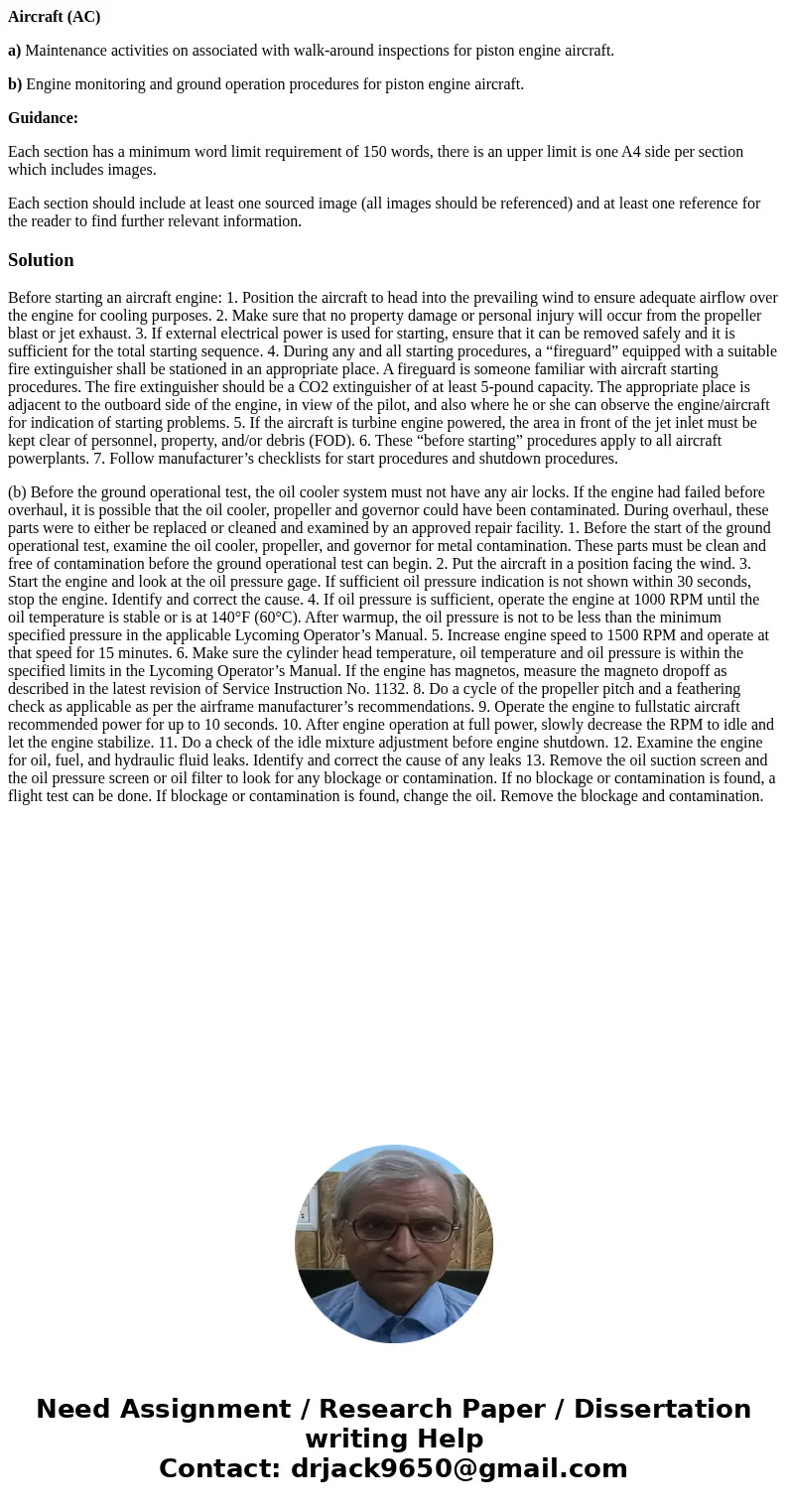Aircraft AC a Maintenance activities on associated with walk
Aircraft (AC)
a) Maintenance activities on associated with walk-around inspections for piston engine aircraft.
b) Engine monitoring and ground operation procedures for piston engine aircraft.
Guidance:
Each section has a minimum word limit requirement of 150 words, there is an upper limit is one A4 side per section which includes images.
Each section should include at least one sourced image (all images should be referenced) and at least one reference for the reader to find further relevant information.
Solution
Before starting an aircraft engine: 1. Position the aircraft to head into the prevailing wind to ensure adequate airflow over the engine for cooling purposes. 2. Make sure that no property damage or personal injury will occur from the propeller blast or jet exhaust. 3. If external electrical power is used for starting, ensure that it can be removed safely and it is sufficient for the total starting sequence. 4. During any and all starting procedures, a “fireguard” equipped with a suitable fire extinguisher shall be stationed in an appropriate place. A fireguard is someone familiar with aircraft starting procedures. The fire extinguisher should be a CO2 extinguisher of at least 5-pound capacity. The appropriate place is adjacent to the outboard side of the engine, in view of the pilot, and also where he or she can observe the engine/aircraft for indication of starting problems. 5. If the aircraft is turbine engine powered, the area in front of the jet inlet must be kept clear of personnel, property, and/or debris (FOD). 6. These “before starting” procedures apply to all aircraft powerplants. 7. Follow manufacturer’s checklists for start procedures and shutdown procedures.
(b) Before the ground operational test, the oil cooler system must not have any air locks. If the engine had failed before overhaul, it is possible that the oil cooler, propeller and governor could have been contaminated. During overhaul, these parts were to either be replaced or cleaned and examined by an approved repair facility. 1. Before the start of the ground operational test, examine the oil cooler, propeller, and governor for metal contamination. These parts must be clean and free of contamination before the ground operational test can begin. 2. Put the aircraft in a position facing the wind. 3. Start the engine and look at the oil pressure gage. If sufficient oil pressure indication is not shown within 30 seconds, stop the engine. Identify and correct the cause. 4. If oil pressure is sufficient, operate the engine at 1000 RPM until the oil temperature is stable or is at 140°F (60°C). After warmup, the oil pressure is not to be less than the minimum specified pressure in the applicable Lycoming Operator’s Manual. 5. Increase engine speed to 1500 RPM and operate at that speed for 15 minutes. 6. Make sure the cylinder head temperature, oil temperature and oil pressure is within the specified limits in the Lycoming Operator’s Manual. If the engine has magnetos, measure the magneto dropoff as described in the latest revision of Service Instruction No. 1132. 8. Do a cycle of the propeller pitch and a feathering check as applicable as per the airframe manufacturer’s recommendations. 9. Operate the engine to fullstatic aircraft recommended power for up to 10 seconds. 10. After engine operation at full power, slowly decrease the RPM to idle and let the engine stabilize. 11. Do a check of the idle mixture adjustment before engine shutdown. 12. Examine the engine for oil, fuel, and hydraulic fluid leaks. Identify and correct the cause of any leaks 13. Remove the oil suction screen and the oil pressure screen or oil filter to look for any blockage or contamination. If no blockage or contamination is found, a flight test can be done. If blockage or contamination is found, change the oil. Remove the blockage and contamination.

 Homework Sourse
Homework Sourse